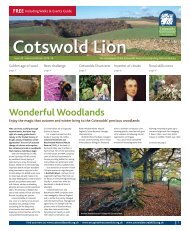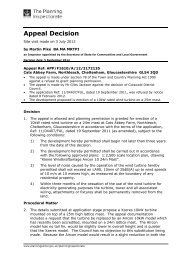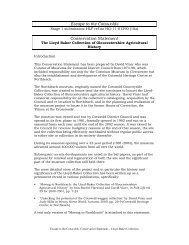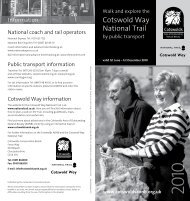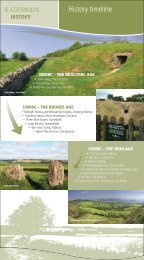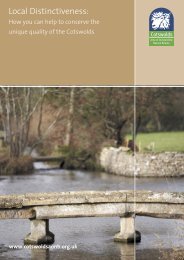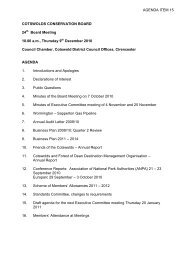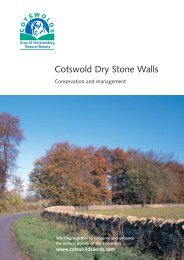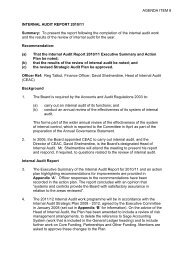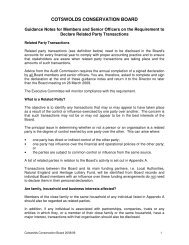AONB LCAR S1 P1-10 FINAL - the Cotswolds Area of Outstanding ...
AONB LCAR S1 P1-10 FINAL - the Cotswolds Area of Outstanding ...
AONB LCAR S1 P1-10 FINAL - the Cotswolds Area of Outstanding ...
You also want an ePaper? Increase the reach of your titles
YUMPU automatically turns print PDFs into web optimized ePapers that Google loves.
2 Evolution <strong>of</strong> <strong>the</strong> Landscape<br />
o<strong>the</strong>r essential equipment. The revival essentially saved<br />
<strong>the</strong>se industrial buildings from dereliction and ensured<br />
<strong>the</strong>ir survival as features <strong>of</strong> <strong>the</strong> modern landscape.<br />
The pattern <strong>of</strong> <strong>the</strong> rural landscape from <strong>the</strong> Great War<br />
onwards was again undergoing significant change;<br />
mechanical reapers, steam traction engines and later,<br />
tractors replaced human effort and horse power in <strong>the</strong><br />
fields. Beyond <strong>the</strong> farm, steamrollers coated <strong>the</strong> <strong>Cotswolds</strong><br />
roads with tarmac, and in <strong>the</strong> towns fine Lias pavements<br />
gave way to concrete and asphalt. It is this period <strong>of</strong><br />
transition that Laurie Lee describes in his book ‘Cider<br />
with Rosie’.<br />
Similar to <strong>the</strong> Great War, World War II saw increased<br />
pressure on domestic agriculture and again <strong>Cotswolds</strong><br />
pastures were ploughed up for grain production. The<br />
tractor, now widely in use, was <strong>the</strong> major agent <strong>of</strong><br />
landscape change at <strong>the</strong> time.<br />
“Mechanisation is being developed increasingly on <strong>the</strong><br />
Plateau, and very large fields... makes this economically<br />
possible... <strong>the</strong> face <strong>of</strong> Gloucestershire will alter considerably<br />
as a result <strong>of</strong> <strong>the</strong> increased use <strong>of</strong> machines”. 18<br />
SECOND WORLD WAR AIRCRAFT HANGAR<br />
The wartime landscape also saw <strong>the</strong> introduction <strong>of</strong> large<br />
airfields. Many have disappeared; however, <strong>the</strong> tarmac<br />
runways and hangars <strong>of</strong> <strong>the</strong> larger establishments still<br />
dominate <strong>the</strong> dip-slope landscape.<br />
18. Gordon E. Payne, Gloucestershire: A Physical, Social and Economic<br />
Survey and Plan<br />
30<br />
<strong>Cotswolds</strong> <strong>AONB</strong> Partnership<br />
2.9<br />
Recent History: (1945 – Present)<br />
Since <strong>the</strong> end <strong>of</strong> <strong>the</strong> Second World War <strong>the</strong> <strong>Cotswolds</strong><br />
has witnessed many changes that reflect national trends,<br />
notably population growth, increased mechanisation, and<br />
greater personal affluence, mobility and leisure time. In <strong>the</strong><br />
past 60 years <strong>the</strong> <strong>AONB</strong> has seen changes so pr<strong>of</strong>ound and<br />
far reaching that <strong>the</strong>y are comparable in scale to <strong>the</strong> those<br />
witnessed by <strong>the</strong> generations present at <strong>the</strong> time that <strong>the</strong><br />
open fields were replaced by a patchwork landscape <strong>of</strong><br />
enclosed fields and small isolated farmsteads. Some <strong>of</strong> <strong>the</strong><br />
changes have been gradual and <strong>of</strong>ten imperceptible, but<br />
over a period <strong>of</strong> decades <strong>the</strong> effects are significant. As a<br />
consequence, <strong>the</strong> landscape that we see today within parts<br />
<strong>of</strong> <strong>the</strong> <strong>AONB</strong> is no longer a reflection <strong>of</strong> <strong>the</strong> traditional<br />
image so <strong>of</strong>ten associated with <strong>the</strong> <strong>Cotswolds</strong>, <strong>of</strong> a<br />
landscape with a timeless quality, and a pastoral retreat.<br />
The most significant changes that have occurred within <strong>the</strong><br />
<strong>Cotswolds</strong> in <strong>the</strong> post war period, and <strong>the</strong>ir consequent<br />
effect on landscape character, are summarised below.<br />
Agricultural Change<br />
• As petrol and materials were released from war<br />
production, agriculture became increasingly mechanised.<br />
Large machinery such as combine harvesters and tractors<br />
required large scale sheds to be constructed and field<br />
entrances to be widened. In many areas, field boundaries<br />
were removed in order to maximise efficiency.<br />
• Ploughing up <strong>of</strong> extensive areas <strong>of</strong> <strong>the</strong> <strong>Cotswolds</strong>, and<br />
<strong>the</strong> conversion <strong>of</strong> permanent pasture for sheep grazing<br />
to arable cultivation for cereal production, has resulted<br />
in <strong>the</strong> most significant landscape change in <strong>the</strong><br />
<strong>Cotswolds</strong>, particularly within <strong>the</strong> high wold and dipslope.<br />
In 1983 <strong>the</strong>re was only a 2% cover <strong>of</strong> permanent<br />
pasture, compared to some 40% immediately prior<br />
to World War II, which gives an indication <strong>of</strong> <strong>the</strong> scale<br />
<strong>of</strong> <strong>the</strong> change that has taken place. Sheep pastures, so<br />
long a feature <strong>of</strong> <strong>the</strong> high wolds, are now a mosaic <strong>of</strong><br />
arable fields, with seasonal variations reflected in <strong>the</strong><br />
changing pattern <strong>of</strong> ploughed field and cereal crops.<br />
• An increase in <strong>the</strong> intensive rearing <strong>of</strong> beef and dairy<br />
cattle has replaced <strong>the</strong> once extensive flocks <strong>of</strong> sheep.<br />
While sheep are still present <strong>the</strong>ir numbers are vastly<br />
depleted. Manifestations in <strong>the</strong> landscape are sometimes<br />
evident in large scale milking parlours or feeding sheds<br />
in close proximity to traditional farmhouses.



